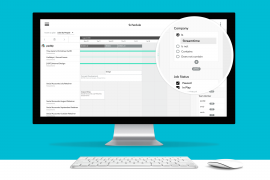Last year, we decided to start building a completely new version of our product from the ground-up. As part of that process we started to investigate the future of project management. For The People‘s Damian Borchok sums it up perfectly in his talk about Streamtime, The Future and the Battle for the Soul of Project Management.
If you’d prefer to read Damian’s insights, here is an edited transcript of this video.
The future of project management
As part of this project, I was asked to look into what the future of Streamtime, the future of project management, could look like. The idea of project management software and running a professional services business has been something on my mind for the last eight or nine years. I used to run Interbrand in Australia as CEO, and so I had to look at lots of different types of software to help run my business. Whether it was financial management software, project management software, timesheet software, etc. I was never a big fan of any of that, so it was a really interesting project to start thinking about. “If I could have my choice, rather than the IT department choosing for me, what would happen?” So some of this is a projection about what Streamtime could potentially be. About the future of project management software.
“Well, if I could have my choice, rather than the IT department choosing for me, what would happen?”
I think about it in the context of not only Streamtime but the business world. As someone who needs to use this software, what does the future look like for running a business of different sizes, different categories, etc. There’s a very substantial amount of change that’s happening in our business world that helps as the context for, I guess, what future choices in software could be like. That that’s an incredibly important element to this.
We need to change our relationship with numbers
A lot of people in the creative industry struggle with numbers, and often even something as simple as doing timesheets is a battle. Numbers can make us do really strange things. Something we need to be very clear about is that even though numbers help us do things, the majority of people in creative industries and other industries actually don’t like working them. They don’t understand them fully. They don’t understand some of the metrics that we deal with. We have to recognise that rather than just simply saying we have to put up with, “This is the way it’s always been.” Because I think any organisation in the future that can actually go “no, it’s not as it’s always been, this is how it could be” will ultimately win. And, you know, it should be for Streamtime to actually do that.
“I think any organisation in the future that can actually go ‘no, it’s not as it’s always been, this is how it could be’ will ultimately win.”
Numbers are relatively soulless. You know, you look at them and they’re fairly cold. Even management consultants mistake people for numbers, and they get a whole bunch of things wrong as a consequence of that. So I think it’s important that we actually think about how numbers can actually illuminate our day jobs as opposed to simply being something that we have to work hard at analysing.
Numbers make us lie. Anybody who’s seen a timesheet that, for months on end people are putting 7.5 hours on, know that all the people that do that are just lying through their teeth. The consequence of that is that the data is inaccurate. That’s when it comes down to my other point, even when we know the numbers are inaccurate, we still think they’re better than no numbers. To me, that’s a dysfunctional thing. I would say most industries are perfectly happy to have the wrong numbers, but at least if they’ve got numbers they’re okay, which I think is absolutely insane. It’s crazy!
“Even when we know the numbers are inaccurate, we still think they’re better than no numbers…which I think is absolutely insane.”
Numbers alienate us, if we don’t relate to them well, we’d rather not deal with them. I know time and time again dealing with a chief financial officer and trying to explain JCRs to them. All that kind of stuff is very, very confusing.
I think numbers at the end of the day make us do weird shit. Time and time again I’ve seen project managers stand over designers and go, “You’ll only put in this amount of time, won’t you?” as opposed to accurate reporting. They don’t want the job to go over, because that will get pinged upstairs and then they’ll come down and ask lots of really uncomfortable questions. So there’s a whole range of dysfunction that happens with numbers that we need to consider in the real life usage and how do we actually overcome that in the future of project management.
“You don’t want the job to go over, because that will get pinged upstairs and then they’ll come down and ask lots of really uncomfortable questions.”
Technology at work sucks!
Technology at work sucks, really badly. Time and time again, I’ve seen, either with clients or within businesses that I’ve worked in, is the CIO or the CTO often says, “Well, it kind of does but that’s what you have just got to put up with.” That’s the lot of business software. There are a number of things we can do a hell of a lot better.
I actually think most of the technology I use in my personal life has been better than the software I’ve used at work. And that’s kind of sad. I’ve worked for multibillion dollar corporations that should be able to afford proper software. My own home is better kitted out, which is crazy. People have gotten used to dealing with mediocre software, and I don’t think that’s good enough for business.
“I’ve worked for multibillion dollar corporations that should be able to afford proper software and my own home is better kitted out, which is crazy.”
I would like that we not wait a hundred years to actually get business software up to a grade that is actually fun to use, aesthetically pleasing, intuitive and all those wonderful things that you often see more in consumer-based software.
Because so much business software has to fit so many features in, it has to make so many compromises, usually the users have to work hard to make the software work for them. And that’s crazy because the whole point of software is to automate all those things rather than actually make people dig in deep.
“Because business software has to fit so many features in and it has to make so many compromises, usually the users have to work hard to make the software work for them.”
The whole world of feature creep is not helping. There are so many features that go into software that nobody uses and you have to make semi-compromises with the design of the software. You ultimately produce something that’s a bit of a Frankenstein and not very friendly to use. So again,when looking at the future of project management, why don’t we start to get disciplined around what are the real things that we need and not enter into that arms race that really doesn’t help anybody.
The future of work is changing
The reality is the future of work is changing, and we need to be able to accommodate this. In the creative industry, they are transforming radically. They have to. They have no choice because so much of what they do is commoditising. The expectation from clients is changing rapidly. The pace at which people have to work, the more efficient that they have to work is hugely changing the nature of the kind of information they have to get, the pace at which they have to get it. The fact that culture is becoming a far more dominant theme in terms of being the operating system of a business, and being able to measure the nature of a culture is becoming important.
Wherever automation can happen is key. Things are becoming far more volatile and so project management is needing to be more dynamic. All of these things influence the kind of software that’s going to be useful, and I would argue that the vast majority of project management software is backward looking and slow in terms of provision of data. Again these things need to be changed so that we can actually capture, the new way of working that’s going to be an expectation of business as usual in the future for clients.
Humanising Project Management
When I was thinking about all this stuff, a quote from Woody Allen’s “Annie Hall,” came to mind, “I was thrown out of college for cheating on the metaphysics exam. I looked into the soul of the boy sitting next to me.” I actually think this is a really wonderful quote, because what we’re talking about here is that we’re not simply looking at numbers as an inhuman thing. We’re not simply looking at people as being resources. We’re actually looking into the soul of a project, and the thing that matters most in the project are the people that are working around it, that are working together every day of the week to deliver something that’s powerful or unsuccessful, depending on how things are managed. To me, if we can have software that is essentially able to look into the soul of that team and be able to provide them with what they need to do their projects properly, to make them better, more competitive, more creative, more effective, that’s the kind of stuff that I would hope people pay decent money for.
“The thing that matters most in the project are the people that are working around it.”
What are some of the things that we want to do if we’re going to look into the soul of a project? As a principle, we should think that the past is past. We shouldn’t simply be producing data that is historical. Time and time again, I’ve been in meetings with project managers who just go, “There’s not much we can do about this project. It’s gone off the boil and we can’t really do anything now for the next two weeks. We’re just going to lose money on it. Bad luck.” I don’t think that’s a good enough condition to be in. So the tools need to be able to contribute to our understanding of the future.
Data needs to be an active participant
Most metrics only speak when spoken to, so you’ve got to go and look for them. They don’t actually go, “Hey, I can see two or three things that are going wrong here right now. You should be looking at them.” And so you have to wait till you get your reports run and that’s too late. So I think data needs to be an active participant in the direction of the project as opposed to being passive, because usually passive is too late.
Most measures focus on time, money and resources, actually not the state of the humans. Most projects fail because of the state of the people, the way they think about things, how they feel, their morale, whether they like the client or absolutely hate them, whether the brief is crap, where they have to work on this thing anyway because they’re made to. All those things actually are a substantial impact on projects in terms of profitability, whether people hang around, whether they actually want to give the time on the job or whether they want to run off and do something else or they want to procrastinate and slow the job down. All of those things are the real things that actually affect a lot of industries. So we want to have a look at the individuals and the teams that actually have that kind of impact.
“Most projects fail because of the state of the people, the way they think about things, how they feel, their morale…”
In a lot of the resource management stuff, we treat humans as fungible resources, which basically means they’re just perfectly substitutable with other humans, which is just nonsensical. People have different skills. People have different speeds of doing things. They can see things differently. They have different experiences they can bring to projects. Yet we often, as a team, when we’re working, we hold that in our heads, but what if software could actually understand that better? And what kind of improvement could that provide? So again how do we account for specific skills of individuals? How do we factor that into the decision-making processes of software?
Where do we start?
This all sounds very future-orientated and science-fictiony, but there are some simple, starting points that we can start to look at in how we might make that work. Whilst this looks like a fair way off, we can already see that there’s change coming, whether it’s things like Slack, which I think is really a wonderful tool in terms of its simplicity, and its focus and its design for real people, is a really good example. Its success is a clear measure of that. At the other extreme, something like Watson, which is starting the process of artificial intelligence actually providing very, very substantial change in the way that we automate the work that we do and the ability for machines to be able to think bigger and faster than humans and to be useful from that point of view so we can make better decisions. There are some things that we can learn from the expectations that the marketplace will have of software for the future.
So what if we integrated some of this thinking into Streamtime? And we conducted a series of thought experiments on how that could play out.
1. Future-based project management
How do we avoid just the historical stuff and actually look into the future. I think when you look at project management, what it really is, it’s a battle for the future. So every time somebody writes an estimate, what they’re doing is predicting what the future should be in terms of their expectations. And what happens between now and that future is that a whole bunch of things that they’re going to hopefully try to predict but typically they can’t predict everything. And so it’s a process of entropy that starts to destroy that perfect sort of expectation that you have. But what if software could actually help provide and inform us of data on a day by day basis saying, “You’re getting closer or further away from your goal of actually seeing that future” and providing information that helps you to understand how you get to that future better.
“When you look at project management, what it really is, it’s a battle for the future. So every time somebody writes an estimate, what they’re doing is predicting what the future should be in terms of their expectations.”
With traditional project management software, the data that comes back is diagnostic in nature. The shift that we’re talking about is prognostic.We future project management tools continually reinforcing. Evaluating the variables that are supporting or weakening a project’s likelihood of success and providing options for improvement. We can look at existing information and reframe that to look at the future rather than saying, “This is what I’ve done.” Things like time and budget, margin profitability around projects utilisation multiples and all those classic, sort of, project management things.
But there are some other things. The first one is whilst we do talk about capacity and we talk about people, we talk about them as bodies as opposed to real humans. When I think about capacity, capacity is people’s headspace to do a project well, not just simply their time available. And do they have the skill or the capability around that capacity to do it? Because some people will do it faster. We know a Creative Director would probably crack a job a lot faster than a junior. But there’re also other more subtle skillsets that we need to consider as well.
“When I think about capacity, capacity is people’s headspace to do a project well, not just simply their time available.”
At the far end is something called clearance, which we often don’t focus a lot on but I think is going to become more and more important. It’s the ability to be able to just get stuff done: how fast can we complete things, how do we actually realise cash faster in terms of cash flows, not simply profitability on a project, how do we shut a project down quickly and then move on to the next one and allow us to be able to, I guess, keep up to date with the pace of change of things. And then what is the right composition of team? Can our software actually analyse different groups of teams working together overtime to go, “Actually these are the best possible combinations that we can have”? That’s so useful for actually understanding how projects can work better.
2. Culture management
With culture management, there’s a growing body of communication, documents, research, study, etc. to say more and more that we’ve left culture on the table for too long. There are more and more organisations that are using culture as their operating system and it is fundamental to the way a business delivers and is often the how of the business like how they actually deliver their service, which is as important as the end deliverable for clients. And so it’s a fundamental piece that I think we can certainly build in some capabilities.
Now when I think about culture, I think purely within the context of a project. I’m not thinking about building an employee engagement system for Streamtime. There’re already plenty of employee engagement methodologies, whether it’s Employee NPS, which is using the traditional Net Promoter Score, but inside the company. Jobvibe is another one that actually allows you day by day to actually evaluate how teams feel. And then there’s the full-scale employee engagement battery of hundreds of questions that people hate doing and it takes forever to get data back.
“At the end of the day, most people stay and leave on the basis of, can I get my job done and do I feel any satisfaction for it?”
So how do we build a system to actually understand how are people feeling at the start, and how are people feeling at the end of this and how do we create a fairly simple way of actually evaluating this stuff? Because I know that often in really crappy projects, the morale and the way people think about it, you see it in how they respond and it tends to show up in the money at the end of the day as well.
There’s a lady called Mary Williams who looks at project management and automation. There were some really interesting things that she looked at, and I’ve kind of adapted some of her thinking. One of the most important things for an employee when they’re working on a project, at the end of the day, is not all the nice things that you might get at work, whether it might be meals during the day, or the opportunity to have a Friday off early and all those kind of nice things that companies obsess about. At the end of the day, most people stay and leave on the basis of, “Can I get my job done and do I feel any satisfaction for it?” That is the largest, single contributor whether people stay above and beyond obviously things like pay.
And so Mary Williams looked at that and there were a number of things that she felt were most important to evaluate. Firstly, what is my purpose? Do I know what I’m doing? Does my team know what they’re doing? And I know time and time again when projects go badly, often people in the team go, “I don’t know what the hell I’m supposed to be doing here.” The brief’s not clear nobody has asked the right questions, and that’s a big contributor to project failure. Secondly is autonomy. Do I have the freedom to do the things I need to do to get my job done or are other things getting in the way of me achieving that? The third one is this idea of mastery. Am I in command of what I need to do and can I do the job well as a consequence of that? That’s a really high rate in terms of job satisfaction. And then the last one is relationship. How productive is my relationship with the rest of my team and my client?
So those four measures, if we’re able to build those in terms of engagement metric, I think we’d be a long way. And in terms of understanding the kind of read on how people feel, being able to cross-correlate that with financial data and start to see sort of a much better way of managing teams. You can add into that things like culture characteristics of a particular organisation because normally those kind of things are becoming more and more defined as metrics as well. But certainly this is an interesting starting point for actually developing measures into Streamtime around things like purpose, autonomy, mastery and relationship.
3. Personal Data
Most software is built around what the organisation needs, and not necessarily around, “I’ve got a career here as an individual. What am I getting out of it and what more can I get from it?” Because you obviously conduct a whole range of projects and you build skills out of that and you sometimes get awards for doing that work. Or you might work with interesting people who have a very high profile and you’d like to be able to tell the world about that. You want to be able to transfer some of that appropriate data. And on top of that, I guess there’s the fact that there’s an obsession with quantified data for people. So people are wanting to know more about themselves in a quantified way and to understand, “How can I improve my performance?” And why wouldn’t you want to do that for your own work life?
“People are wanting to know more about themselves in a quantified way and to understand..How can I improve my performance?”
On top of that, we have the fact that more freelancers and contractors are becoming a day to day reality. Typically in the next 5 years, a 30% to 40% increase in freelancers in organisations and contractors within Australia and the U.S. And that’s going to only continue. So if you’ve got people sort of more freewheeling, that data needs to be far more transferable.
So what are some of the roles a personal data can play? I think it’s as much for the organisation as it is the individual. Firstly, for performance contribution and improvement, so that you can see the performance of individuals and you can capture that data. We can have a look at project, and culture and skill fit if we have that kind of data and it is transferrable. It’s a good record of real credentials, potentially employee sharable and transferable. But also the ability to be able to improve that data should be an incentive and a reward. And to be able to show that and to be able to demonstrate that is key.
So we’ve looked at a whole different bunch of different things, whether it’s how do you visually represent data and a whole bunch of companies including Apple are looking at that. LinkedIn has done a reasonable job of actually building up skillsets and endorsements, and I think those are potentially quite powerful for some people. What happens if we could integrate with them? Would they allow us to integrate with them to actually add on to that and to be able to introduce that kind of data back into the business?
What’s next
There are three levels that we can start to look at and potentially build into Streamtime. Firstly, the metrics: we need to capture data, so the skills of the person, the role attributes, granular or specific achievements that people could make within the life of a project and the kind of cultural attributes that they start to build up. And then from that, we can start to create, on the basis of these behaviours being achieved, reward generation. And some of these rewards may be generated by your own team members or they could be actually generated just simply through the data that’s been captured and the software going, “actually you’ve ticked the boxes on these sort of things, so there’s particular awards that can be achieved.”
And ultimately you can start to build out a whole bunch of personal data and that can sit on the system or you can also take that with you when you go to your next job. So there are a whole range of things that we can play around with in terms of how we make all of this work.
Those are some of the thought experiments that we look towards as a starting point. We have to build out these and start to get sensible about how they might really work. And I think when I was talking to Aaron, he made the point, “Is this Streamtime’s future or just pie in the sky?” because a lot of it is not fully considered. While it is still quite abstract, I think if you break it down to those elements, all of them are achievable to a certain degree…so watch this space. Streamtime can be the future of project management.
Damian Borchok is Co-Founder at For The People.







